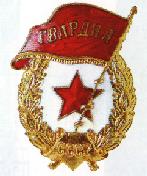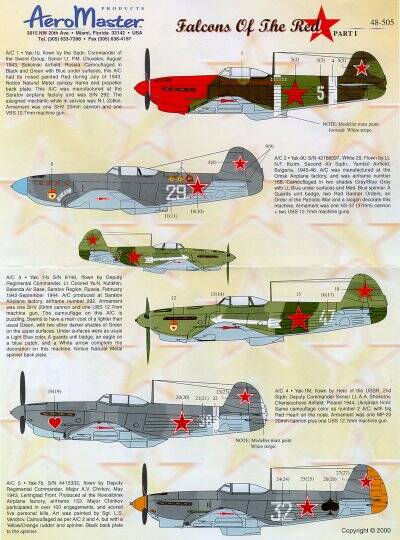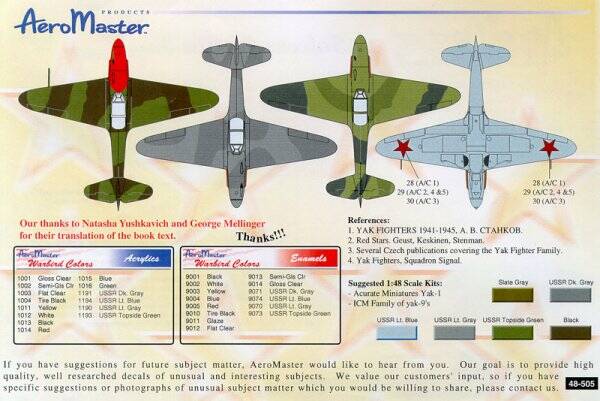Decal Sheet Review: VVS Fighters,
Part V

In our forthcoming decal sheet review series,
we'll seek to highlight and critique some of the currently available-- and long
past issue-- VVS decal sheets. In this next of a series of installments, we'll
take a look at a new 1:48 scale VVS Fighter sheet.
[All decal sheet scans have been deliberately
skewed and distorted at random angles to dissuade illegal reproduction or Copyright
infringement by any such parties. The precise line and measurement of any specific
marking, therefore, should not be taken literally from these illustrations.]
AeroMaster Products Sheet No. 48-505
"Falcons of the Red Star, Part I"



AeroMaster has released this new sheet of VVS fighters based on
profiles out of A.V. Stankov's book "Porshnevie Istebiteli Yak; Perioda 1941-45
v Polkakh VVS Vol.2" ("Yak Piston [engined] Fighters of the 1941-45
Period in VVS Regiments Vol.2") [Ukraina i Mir 1999]. Stankov has served
in the Ukrainian Air Force Command, and is a technical consultant to several
journals and other publications on modern VVS subjects. Alas, he has no specific
expertise in Great Patriotic War era subjects, and this fact is reflected in
the volume at hand.
Stankov was clever in retrieving photographs from collections
that are unusual and unexamined by normal VVS historians. Many of the pictures
published in "Yak Vol.2" appear to come both from individual pilots (whom
Stankov did interview), and also from curious sources like magazine and newspaper
archives. These are invaluable in that they were previously unknown, and show
interesting subjects. However, they are also difficult in that the vast majority
of these photographs were taken with the low-quality, high-sensitivity journalistic
type film that I complain about at length on this site (and elsewhere). These
images are extremely poor in virtually every respect, and are very difficult
indeed to analyze with any accuracy. Compounded by Stankov's lack of GPW-era
VVS research credentials, the results in "Yak Vol.2" are not inspiring.
Alas--and this should in no way be construed as a
criticism of AeroMaster--the resulting decal sheet, based on this volume, reflects
many of Stankov's errors. That being said, the decals themselves are quite excellent,
are said to apply and adhere well to all prepared surfaces, and do not 'silver'
or bubble with the application of solvents.
Let's turn our attention to Stankov's profiles, and the
resulting schemes.
Decal Sheet Schemes
- Yak-1B "White 5", Nikolai Zotkin, 427 IAP. Despite the existence of overwhelming
evidence on the printed photograph for shading and the effects of lighting,
the numeral "5" has been interpreted as being silver in color. This idea is
utterly insuperable, and the hue value present on the picture in no way matches
the appearance of AII Aluminum on any film type; it is certainly white. There
is also no hint of a black border around the national star on the fuselage
side, which is a plain red type. The star on the fin/rudder is trimmed in
white again, with similar observations on a spurious 'silver' interpretation.
The upper view of the camouflage scheme as drawn by Stankov is incorrect.
The actual scheme present is a rather 'messy' version of a common 1943 Saratov
pattern in AMT-6/-4/-7. The cowl and spinner are completed in red.
- Yak-9U "White 29", Georgiy Stepanov, 151 GIAP. The decals set provided for
this machine are excellent, and modelers will have no trouble producing an
authentic version of this aircraft with them. The side camouflage profile
provided by Stankov is quite beyond comprehension, and should be ignored.
The markings, however, are expertly drawn. The spinner appears to be white
in color; I cannot imagine how the artist decided that it was blue. The color
scheme here looks to be a 1944 Omsk applied pattern in AMT-12/-11/-7.
- Yak-1B "White 47", Yakov Kutikhin, 156 GIAP. The two photos published of
this aircraft are amongst the worst of the entire "Yak Vol.2" book,
and this makes any analysis quite difficult. The evidence on the pictures
points to a Black over Green scheme, almost certainly AMT-6/-4/-7 given the
date. There is no evidence of AII colors, including AII Dark Green. The visible
pattern does not correspond to any known Factory application, and there is
evidence of considerable re-painting. As such, a field applied camouflage
is likely, but the pattern suggested by Stankov seems thoroughly improbable.
Once again, there is no evidence for black borders around any of the nation
star markings; these are clearly plain red types. The 'eagle' and 'arrow'
artwork is well completed, and seems to be accurate.
- Yak-1B "White 38", A. Shokurov, 156 GIAP. The available photograph of this
machine is completely useless. Showing only a close-up of the nose and pilot,
and being of the poorest possible quality (over-exposed journalist type film
with bad camera settings), no critique of the scheme is possible; it remains
unknown. One might note Stankov's continuing use of the ridiculous nomenclature
"Yak-1M" as a guide to the accuracy of this scheme.
- Yak-7B "White 32", E. Shutov, 29 GIAP. No photograph is provided of this
aircraft, and therefore the scheme remains unknown. Stankov cites the Production
Number for this machine as No.4415332; if true, the machine would have been
painted in a Black/Green (AMT-6/-4/-7) livery, not in greys (AMT-12/-11).
One also hopes that the resulting trim color is a printing difficulty in the
book "Yak Vol.2" and was intended to be yellow, and that Mr.Stankov
is not seriously suggesting that the spinner and rudder were painted with
'Safety Orange'.
Upper Surface Patterns
The upper surface camouflage details offered
by Stankov are completely incorrect and cannot be corroborated by any photograph
of the GPW era. Many of the correct pattern applications can be found on this
site. Modelers are urged to be careful and keep this situation firmly in mind
when completing their subjects from this sheet.
Summary
AeroMaster's sheet "Falcons of the Red Star, Part I" is another
fine decal effort led astray by rather dubious resource material. AeroMaster
should be congratulated for releasing another set of nice VVS decals, however.
The accuracy, registration, and properties of these sheets are quite good, and
I (for one) look forward to the work of this company when more accurate sources
of information on VVS aircraft emerge in print.




